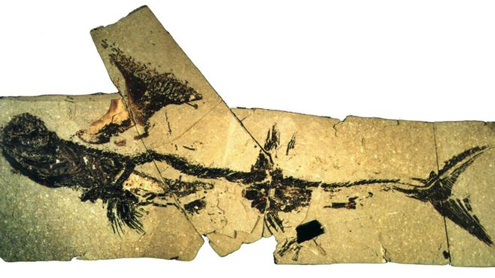Plaque and Cairn for the “Bearsden Shark”
It might not quite match the celebrity status of the Loch Ness Monster, but a metre long prehistoric shark which once swam in a shallow sea that covered much of Scotland, has been honoured by having a cairn and a plaque erected on the site where its fossils were found back in 1981.
The shark named Akmonistion zangerli is represented by one of the most complete cartilaginous fish fossils known from the Carboniferous, it is a member of the Stethacanthidae family of ancient sharks nick-named “the ironing board sharks” due to the shape of the male sharks dorsal fin. The shark is known locally as the “Bearsden shark” as the fossils come from Manse Burn close to the town of Bearsden which is located just to the north-west of the city of Glasgow.
The Beautiful “Bearsden Shark” Fossil
Picture Credit: The Hunterian Museum
A Scottish Shark
The picture above shows the fossilised remains of Akmonistion zangerli. The broad head is to the left of the picture and the bizarrely shaped dorsal fin can be clearly made out. The black shales from which this fossil was extracted represent sediments laid down at the bottom of an ancient sea. A lack of current and a very poor level of oxygen at the bottom of the sea permitted the excellent preservation of the cartilage that made up the skeleton of this prehistoric fish. Dr Neil Clark who was present at the unveiling of the plaque to commemorate this important discovery, carried out his PhD on the fossil, he stated:
“This is the best preserved fossil shark of its time in the world. It was a very special discovery because in most fossils it is only the hard shelly, or bony, structures that are preserved while the soft tissues generally rot away. From the tip of its nose to the end of its tail, its fragile cartilage skeleton is almost intact after 330 million years locked in the black shales of Bearsden. Even the partly digested remains of its last fish supper lie undisturbed still within the bowels.”
The actual fossil is on display at the Hunterian Museum (Glasgow University), but a small community group, aided by funding, including a generous donation by the company Tarmac has campaigned for the fossil find to be marked in some way at Manse Burn. Earlier this week, a cairn and a plaque commemorating the importance of this discovery was unveiled.
Photograph Shows Campaign Team
The photograph issued to the press shows (L to R) Amanda Stewart (Chairwoman of the Baljaffray Residents Association who started the campaign, Nan Lawless, Dr Neil Clark (Curator of Palaeontology at the Hunterian Museum), Andrew Kent, Neil Buchanan, Stephen Cowan, Debbie Macrae and Provost for East Dunbartonshire Una Walker.
Akmonistion zangerli
Provost Una Walker said:
“It is a source of great pride that such a significant scientific discovery was made in our area and it is thanks to the hard work of the local residents that the site is now properly marked.”
Although formally named Akmonistion zangerli back in 2001, the shark is still affectionately called the “Bearsden Shark” by locals. The site itself has received special protection as a site of special scientific interest (SSSI).
A Model of a Typical Member of the Stethacanthidae Shark Family
Picture credit: Everything Dinosaur
The picture above shows a model of a typical Stethacanthidae shark like Akmonistion zangerli, it is one of the excellent shark models in the prehistoric shark toob made by Safari Ltd.
To view the range of Safari Ltd prehistoric animal models including the prehistoric shark toob: Safari Ltd. Wild Safari Prehistoric World Models.








Leave A Comment